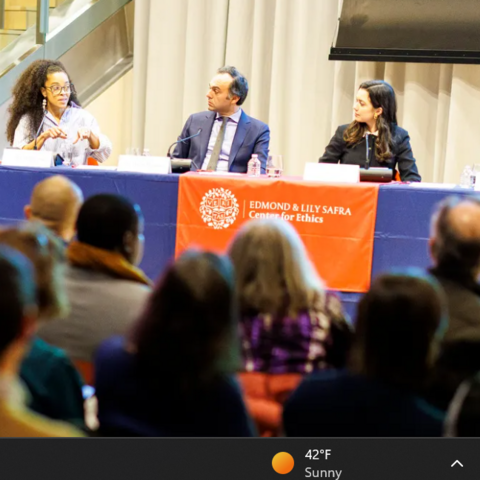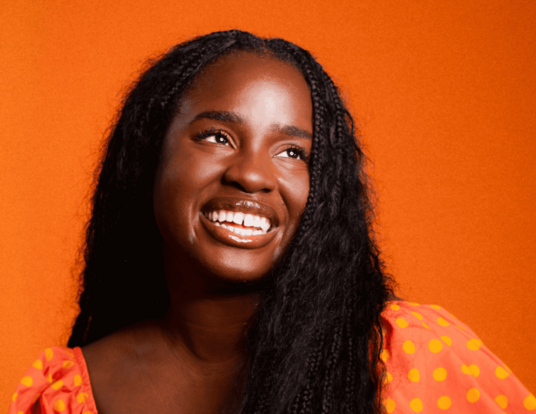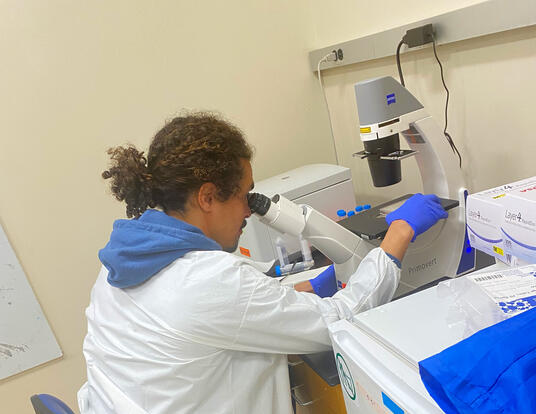The Art of Inclusion
Creating art spaces that transcend, connect, and inspire

Amanda Figueroa thinks about art—not as static objects on a wall or as symbols of colonial power and conquest, but as experiences that bring together people from many different perspectives and as spaces for a revitalized and inclusive civic life. The co-founder of Brown Art Ink, “a nomadic community incubator to support the arts ecosystem for artists, cultural practitioners, and communities of color,” the fifth-year PhD candidate in American Studies explores “Chicana feminist approaches to museum exhibition design and visitor experience data gathering” at Harvard’s Graduate School of Arts and Sciences. (GSAS)
In 2018, Figueroa worked with renowned artist Teresita Fernández on Autumn (…Nothing Personal), an art installation in Harvard’s Tercentenary Theatre inspired by the writing of the African American novelist and social critic James Baldwin. She spoke recently with GSAS communications about the project, about civic and public art education, and about her work to create new art spaces that are vibrant and inclusive.
GSAS: You’ve studied the role of public art in civic life. You worked for two years to bring the Fernández installation in Harvard Yard to fruition. Why does public art matter? What role does it play in helping us to learn to be in community with one another as neighbors and citizens?

Figueroa: Think of Guernica by Picasso. It’s this huge mural that you just look at. It's not beautiful. It's not even pleasurable. It's kind of gruesome. That encounter with something that's so much larger than you produces a kind of shock. There’s a sudden understanding of how small you are in the world.
Afterward, you take your impression of the painting and you go talk to someone else and you say, “Oh, I think it’s about the horrors of war and man’s inhumanity to man.” And the other person might think, “No, it’s just about where Picasso was personally at a turbulent time in his life.” There's no right or wrong answer. It can be both about man's inhumanity to man and about Picasso at that time in his life. It can be about trauma. It can be about fear. All those things can be true at the same time.
That’s why I think public art is critical. Civic education is how we learn to be a good participant in a democratic society, a good neighbor, a good family member. Art teaches us how to look at something, have an opinion about it, and sit comfortably with the knowledge that other people might not see it the same way. And I think you can see the cost of inadequate civic education—and bad public art—in, for instance, the way some people respond to the Black Lives Matter movement. They look at the protests and say, “All lives matter!” Both are true, right? In fact, when we say, “Black Lives Matter,” we are saying “All lives matter.”
But I think the piece of civic education that's most missing is not just the ability to sit with other ideas—as important as that is; it’s a kind of joy, an appreciation or gratitude for the world that we live in. When you appreciate and you're thankful for the world you live in, you appreciate the other people who live in that world, even if you don’t agree with them. That appreciation is what keeps us from saying, “Okay, now I must destroy you.”
GSAS: What does your work tell us about the place of art in communities of color?
Figueroa: It tells us that there’s plenty of art in communities of color, but it’s heavily policed and criminalized. In El Paso, Texas, for instance, where I grew up, people put up these beautiful chalk murals that publicly remember and grieve the women who die in a very specific pattern of surveillance, sexual assault, torture, and violence. Because it never rains, the murals can stay up indefinitely. But every time someone important comes to visit—or when one of the mayors of El Paso or Juarez is “cleaning up the city”—they go and they wash the mural away as if to wash away the shame of the women who get murdered.
What’s also lacking in these spaces is the enfranchisement of art by community members. In Boston’s Roxbury neighborhood, for instance, there are very few gallery spaces. There are very few museums in Roxbury. As a result, there are very few public gathering spaces that public art produces. That's a way to prevent communities from organizing. That's a way to prevent people from having space where they can come and say, “Here's what we're gonna do.”
GSAS: In addition to public art, you study, from the perspective of a person of color, the way that museums operate and are organized. How do people from non-white racial and ethnic backgrounds experience those spaces?
Figueroa: Well, a student group of Black and Brown Dorchester and Roxbury students on a field trip last year were harassed at Boston’s Museum of Fine Arts. The kids were there to learn and instead got an ugly, formative experience.
There's no compassionate way for a person of color to stand in a museum and have an experience that’s not in one way or another traumatic.
That's not new. Museums have always been tools of colonization. The Western tradition is rooted in the British Museum, which was established to demonstrate the might of the empire by showcasing all the artifacts and art and treasure that they took from India and North Africa.
GSAS: The British Museum opened in 1753, though. What’s the approach to multiculturalism and museology today?
Figueroa: Today, museums say, “Oh no. We're changing. We're different now.” But they’re not, really. It's very standard in the field, for instance, to have an object gallery. And, most often, things are organized on a shelf by culture, out of time. So, you see a mix of things that were made in maybe the year 200 and then the year 900 and the year 1600. You lose all sense of time.
This is why people think the Aztecs fell long before the American Revolution when, in fact, Cortez destroyed the Aztec Empire in the 16th century. The result is that you end up with a historical politics that sees western culture as inherently modern and advanced and is completely unable to see the technological achievements of other cultures. I mean, the Aztecs had indoor plumbing!
This kind of museum practice forces the visitor to make an ontological choice. I’m a woman of color. I go to a museum and look at a case of objects from, let's say, indigenous cultures in northern Mexico, which is where I'm from. If I choose to see these objects as a member of that culture, I have to be dead and out of time and colonized and a victim and invisible. Or I can stand there and choose to look at the objects with the perspective of a white colonizer, in which case, at least I get to be alive and have agency, but look at all the ugly things that I do. There's no compassionate way for a person of color to stand in a museum and have an experience that’s not in one way or another traumatic.
GSAS: So, how could things be different? How do communities and institutions create an experience of art that’s revitalizing for all people? And how is your work at the GSAS helping to get us there?
Figueroa: When I worked on Autumn (…Nothing Personal) at Harvard in 2018, what I really loved about it was that the artist, Teresita Fernández, always wants her work to be activated by local community members. A lot of work that she's done becomes gathering places for people. The structure of the artwork itself is a landmark.
Now, what’s visually interesting about Harvard Yard, the site of the installation, is that it’s so uniform. The landscape architects preserve what's called a visual line of sight: the ability to stand at any point see clear through to the other side. Every part of the Yard is visible all at once and every space is uniform. That’s structurally and conceptually important to Harvard's identity.

I was Teresita’s research assistant and I saw this landscape and I took an idea to her. I thought it would be so interesting if the point is to have that visual line of sight, to see what happens when you interrupt it?
The piece that Teresita created in that space was both vertical and horizontal. It had wooden benches and orange and yellow polycarbonate tubes that came up the top. LED lighting shined up through that. When it lit up at night, it was truly, truly beautiful.
She wanted to open her space up to allow other performers, other artists, other student and activist groups to come in and use it, so the piece was structured with concentric circles and an open round space in the middle that was very stage-like. The installation also became a gathering space, especially for students of color, for whom there is no Multicultural Student Center at Harvard. In 30 days and we did 47 programs—including a public reading of James Baldwin’s essay Nothing Personal, which inspired the piece.
I think that’s an example of an art space that got things mostly right. That's the great feat of what Teresita does. It’s an intervention, but it’s not scary. It's not violent. It's not disruptive. It's an intervention that says “You can be part of this too. You also can intervene.”
Photo courtesy of Amanda Figueroa. Photo of art installation by Essa Li.
Get the Latest Updates
Join Our Newsletter
Subscribe to Colloquy Podcast
Simplecast





